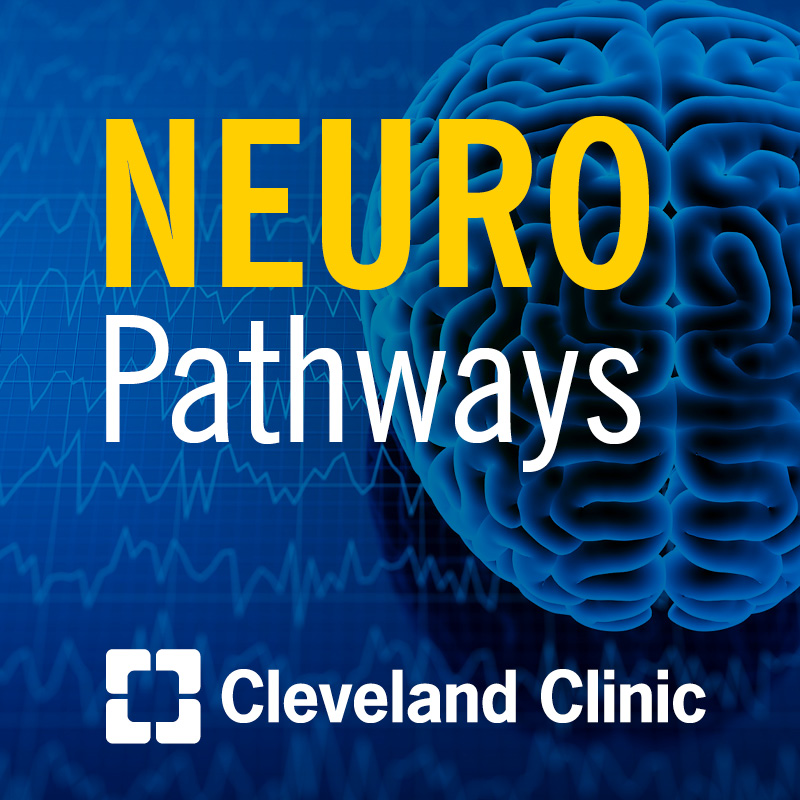Next Frontiers in Monitoring the Progression of Multiple Sclerosis

Treatments for multiple sclerosis have increased in the last decade, making early diagnosis and patient monitoring an important piece in overall care. As a result, relying on standard MRI and checking patients’ reflexes may no longer be enough. In this episode, Robert Bermel, MD discusses emerging technologies that meet the needs in MS patient care, such as the central vein sign and optical coherence tomography.
Subscribe: Apple Podcasts | Podcast Addict | Spotify | Buzzsprout
Next Frontiers in Monitoring the Progression of Multiple Sclerosis
Podcast Transcript
Alex Rae-Grant, MD: Neuro Pathways a Cleveland Clinic podcast for medical professionals exploring the latest research discoveries and clinical advances in the fields of neurology, psychiatry, neurosurgery, and neuro rehab.
Multiple sclerosis affects approximately 1 million individuals in the United States and two and a half billion people worldwide. Current goals of MS management include the treatment of acute relapses, prevention of future relapses, prevention and management of symptoms that affect quality of life and adherence to a healthy lifestyle. In today's episode of Neuro Pathways we're talking about the next frontiers in diagnosing and monitoring the progression of multiple sclerosis. I'm your host, Alex Rae-Grant neurologist in Cleveland Clinic's Neurological Institute. I'm very pleased to have Dr. Rob Bermel join me for today's conversation. Dr. Bermel is director of the Mellen Center for Multiple Sclerosis and staff neurologist in Cleveland Clinic's Neurological Institute. Rob, welcome to Neuro Pathways.
Robert Bermel, MD: Thanks so much Alex.
Alex Rae-Grant, MD: Rob so our listeners can learn more about you tell us where you're from, where did you train and when did you begin your career at Cleveland Clinic?
Robert Bermel, MD: All right. Thanks. So I am originally from Buffalo, New York, came to Cleveland almost I guess 17 years ago now, did my medical school in Buffalo. That's actually where I fell in love with taking care of patients with MS. I had a very charismatic and accomplished mentor there in Buffalo who was part of developing some of the earliest therapies for MS and he indoctrinated me into the idea of integrating clinical care and clinical research and was instrumental in getting me involved in MS and also getting me to Cleveland because he was the one who initially recommended getting here and working with the great people that we have here. I always had in my mind, held up the idea that the clinic in general was a fantastic place to practice medicine but particularly in MS it's a really accomplished group and a fun group to work with.
Alex Rae-Grant, MD: So Rob, let's start broadly. Can you describe a little bit about the current approaches to managing patients with multiple sclerosis?
Robert Bermel, MD: Sure. So MS as a disease as far as neurological diseases go is the one that's the furthest along in terms of actually modifying the course of the disease. So we went from roughly 20 years ago not having much in terms of being able to treat MS to now having over 15 options to treat MS. And that's been a really fun evolution to watch because we have in addition to being able to treat the disease in parallel with that really evolved our thinking about what does it mean to see a patient with MS in clinic. How do we monitor them? How do we follow them? And what can we actually do for them based on what we see?
If you think of a field where there's no disease modifying therapies, think of Alzheimer's disease where really we provide support, we provide symptomatic therapy and maybe a little bit of treatment it makes things like monitoring and even diagnosing a little bit less important. As soon as we had really, really effective therapies for MS all of a sudden the issue of getting the diagnosis correct really, really matters because you would want to use the therapies as early as you can. And the idea of, "Well how should I monitor to make sure I know my treatment's working," really matters because you have different choices, different options about what to use.
Alex Rae-Grant, MD: So what would be wrong with just the standard way that we as neurologists monitor people? You see them in the office, you check their reflexes, you check the Babinski sign. I mean how does that lack in terms of monitoring for this particular disease?
Robert Bermel, MD: So I think that the way we practice and the activities that we do in the course of a clinic visit or over the course of following a patient with MS throughout their life has to evolve with the therapeutic options that we have. And I think the techniques that have been the tried and true techniques of neurologists, checking eye movements and a detailed cranial nerve examination and checking reflexes those are still a fundamental part of what we do especially in new patient visits for the diagnostic purpose. But once you've assigned the patient a diagnosis and know exactly what's going on and you've excluded other possibilities I think what we can do is narrow what we do to focus on what are the most sensitive markers of disease activity.
And in MS we have some experience through clinical trials of knowing what those things are. We know that MRI is a really sensitive way to monitor for inflammatory disease activity in MS and so that's how that got incorporated into clinical monitoring for MS. And likewise though checking reflexes is part of the diagnostic procedure for sure and may be a part of following patients over time it's probably not the most sensitive way to follow patients with MS so that's why we're working on other possibilities.
Alex Rae-Grant, MD: Yeah, so let's talk a bit more about the kinds of things that we're monitoring at the Mellen Center and maybe a little more about why those particular things are being monitored.
Robert Bermel, MD: Well, there's a couple of things that, first of all we're hoping to integrate into the diagnostic procedure for patients with MS eventually and certainly not ready for primetime yet but there are new imaging techniques. We've all encountered the problem of patients who present with white spots on their brain MRI scan and trying to determine are these white spots more consistent with MS or are they less specific white spots that we sometimes see in microvascular disease or patients with migraine headaches or things like this. And we're hopeful that a new technique called the central vein sign might help to differentiate white spots that are related to MS versus white spots due to other causes like microvascular disease.
The central vein sign is rooted in something we've known for a long time and that's that MS lesions in particular tend to be perivanular. And now there's actually been development of an MRI technique which can be done at 3 Tesla which is a large percentage of the clinical scanners that are out there in the real world these days and is not that much additional scan time that may actually be attainable in many different clinical environments. And so, right now there's an initiative through so called NAIMS the North American Imaging and MS Collaborative, of which we're a part, to actually validate this thing called the central vein sign. Where whether its radiologists or neurologists could look at these images and actually classify whether a large percentage of the patient’s white matter lesions have a central vein associated with them and that that could enter into some of the diagnostic help when you're trying to differentiate MS from non-MS white spots.
There's another technique that we're hoping to get into the diagnostic realm and that's this eye scan called OCT where neurologists have used visual evoke potentials for a long time to substantiate a prior optic neuropathy that's occurred to a patient. Well, it would be really nice if we had a technique that's even more accessible to neurologists than that, something called Optical Coherence Tomography or OCT and there's a collaborative as well called IMSVISUAL which we're a part of working on validating retinal nerve fiber layer loss as a surrogate for prior optic neuritis. These are things that MS neurologists for sure will become familiar with in the future and even general neurologists could have some accessibility to these techniques through sub specialists that they touch upon. If you have radiologists that you work with central vein sign might be something that they could use. If you have neuro ophthalmologists that you refer to our work with being familiar with OCT and getting those results back might be really useful.
Alex Rae-Grant, MD: So Rob, let's go back and talk a little bit more about clinical parameters that we're measuring both in the clinic and in a research sense. Can you talk a bit about the work we're doing? You're looking at various clinical measures even before the patient walks in the door to see the doctor.
Robert Bermel, MD: One of the things that we feel is very important is to be able to quantitatively monitor the patient over time and neurology notes, progress notes that are generated from office visits have long been a very subjective piece. And we'd like to add to that a quantitative piece where we assess how patients feel they're doing through validated patient reported outcomes. And in our practice we use something called the Neuro-QoL which is a 10 dimensional battery that's an NIH toolbox validated measure of neurological function. Those are questions that the patients can do from home or after they get into the office in the waiting room.
And then we also test neuro performance measures so things like a Nine Hole Peg Test, a timed 25 foot walk, processing speed test for cognition and a low contrast letter acuity test, four modules that we've known for a long time in MS as a part of the MS functional composite. We're acquiring routinely in an automated way in patients in our practice to make sure that we have those numbers. It doesn't prevent us from examining patients but it augments how we follow people over time. It's really nice to be able to graph people's progress over time and show them that things are stable or if something is off actually be able to document that quantitatively and it's really useful for looking at patients together as a group. So if we want to say, "Hey, how are our patients altogether doing?" Or, "Are there groups of patients that we should be looking at a little bit more closely or measuring outcomes?" We could do that using the quantitative outcome measures.
Alex Rae-Grant, MD: So one of the things that people say about MS is it's a really complex thing, you're doing an MRI every year, you're doing this neuro exam stuff why don't you guys have a blood test for MS progression? I mean is there any movement in that direction?
Robert Bermel, MD: Sure. So I think if you could really look into the future of MS we'll actually hopefully have gauges on multiple fronts. So the patient reported outcomes to get the patient's impression of how they're doing, the neuro performance to see how they're actually functioning in different domains. MRI for sure and MRI is going to move from a more qualitative report generated function to hopefully more of a quantitative function where we can more specifically flag new lesions in a computer assisted way more specifically flagged brain atrophy when it's there in excess in a computer assisted way and finally blood tests.
As you mentioned Alex, the development of a blood test for monitoring the neurological status in a patient with a neurodegenerative disease would be really welcome and Neurofilament Light or NFL is probably the best candidate that we have right now and that's actually in the early stages of being formally validated as an outcome measure in MS. It gets tricky actually when you're drawing blood tests like neurofilament light that the levels get higher as people age, they get higher if people have certain risk factors, they get higher if you've had something as simple as a concussion for instance. We know they elevate even after non neurological surgery. And so, sorting out what the numbers mean and what the equivalent of a normal range would be for a given patient and giving a provider who might order a blood test like this some context around it and helping them to interpret it that's the work of the researchers of which we're a part who are really validating this blood test so that we know how to integrate it into our clinical practice.
Alex Rae-Grant, MD: Obviously Rob there's a very active experimental therapeutics program at the Mellen Center but anything you'd like to particularly highlight it this time that's exciting to you?
Robert Bermel, MD: Alex we're excited about many of these different potential monitoring techniques and that's why we've been closely engaged. So for instance around the central vein sign we have a study that we're actually leading, that Dan Antonito is leading, that's called the CAVS- MS study. So those who are basketball fans might think it's a basketball study but it actually is about the central vein as a diagnostic test for MS and thankfully Mellen is able to take the lead on that.
There's another trial which is the MS PATHS study where we're actually in over a thousand of our patients who have been willing to donate bio samples to a biobank we then had that biobank plus very detailed phenotyping data on the patients that we can go to now and we can validate the neurofilament light blood tests in those patients. So this is a wonderful combination of efforts between the clinical side of the Mellen Center where the patients are willing to get engaged in research and really help to develop those diagnostic techniques, monitoring techniques of the future. It's where the two sides of the house, the clinical and the research sides really are interacting in a really nice way.
Alex Rae-Grant, MD: So one of the things is now that we have a lot of different tools to monitor our population do you think that's been part of any kind of change in terms of the goals we set for them? I know when we started the MS business some time ago we'd put people on a medicine that have relapses and we keep them on the medicine and they'd have relapses. Have the goals of treatment change somewhat and if so what are our goals now?
Robert Bermel, MD: As our capabilities have evolved in the MS treatment realm I do think that our standards have gone up and we're tolerating less in terms of disease activity.
And it's been interesting to watch the field of MS evolve and be part of its evolution from tolerating relapses. What's a relapse every couple of years between friends when you don't have many options to switch a patient too to one where we were very vigilantly monitoring for disease activity and responding to it. To now you know even evolving towards where we believe there's a window of opportunity early on in MS where we should probably use our best therapies early on in testing that hypothesis.
And so, as our treatment options have expanded it's become even more important to monitor patients closely especially early in the disease to make sure that we're doing our job of achieving tight disease control I would say. And MS leads the way I think in terms of neurological diseases. It's further in its evolution and I am hopeful that it will actually serve as a model for other neurological diseases. If you could hope that 10 or 15 years from now Alzheimer's disease would be in a similar place where we have multiple options for disease modification and we're tailoring the options to which one might work best in a given patient. And then following that person very closely where it's actually important for them to come back to clinic, check in with us, maybe get a diagnostic imaging test, maybe get a blood test to monitor things. I am so glad that we're there in MS and I really that we get there in other neurological diseases as well.
Alex Rae-Grant, MD: So Rob, before we sign off any closing comments for our audience on the future state of MS care delivery? I mean where do you see it going from here?
Robert Bermel, MD: Yeah, so the field of MS has advanced very quickly and I think that it becomes even more important for the field of neurology to stick together in a situation like that. And I think that what you're going to see hopefully is you'll see people who do a lot of MS like we do at the Mellen Center connecting with people who do some MS and also do a lot of other things in neurology so that we can keep the lines of communication open and get the care out into the community and to the patients where they really exist.
Because even though we see a lot of patients at the Mellen Center we see a very small fraction of the MS patients that are out there in the world. And what I'd love to do and it's great to have opportunities like this to really try to make that connection and make sure that our colleagues know that we are a resource for them to pick up the phone and call and talk about particular issues or patients to get patients in to see us if they need but also just to ask questions. And so, I think it's going to be that connection to get the word out that's going to be particularly important.
Alex Rae-Grant, MD: Well Rob, this is really helpful and exciting stuff for us to hear so thank you so much for joining us and we look forward to seeing how these changes affect the way we monitor and care for our patients in the future.
Robert Bermel, MD: Great. Thanks so much Alex.
Alex Rae-Grant, MD: This concludes this episode of Neuro Pathways. You can find additional podcast episodes on our website, clevelandclinic.org/neuropodcast or subscribe to the podcasts on iTunes, Google Play, Spotify, SoundCloud, or wherever you get your podcasts. And don't forget you can access real-time updates from experts in Cleveland Clinic's Neurological Institute on our consult QD website. That's consultqd.clevelandclinic.org/neuro or follow us on Twitter @CleClinicMD. All one word that's at C-L-E, Clinic M-D on Twitter. Thank you for listening. Please join us again soon.

Neuro Pathways
A Cleveland Clinic podcast for medical professionals exploring the latest research discoveries and clinical advances in the fields of neurology, neurosurgery, neurorehab and psychiatry. Learn how the landscape for treating conditions of the brain, spine and nervous system is changing from experts in Cleveland Clinic's Neurological Institute.
These activities have been approved for AMA PRA Category 1 Credits™ and ANCC contact hours.


